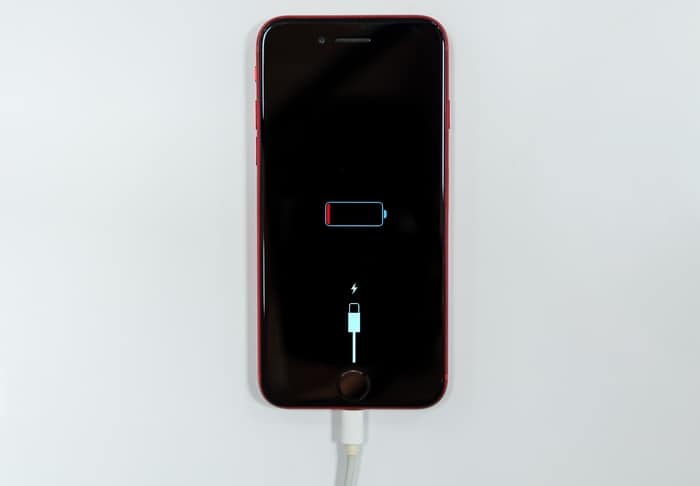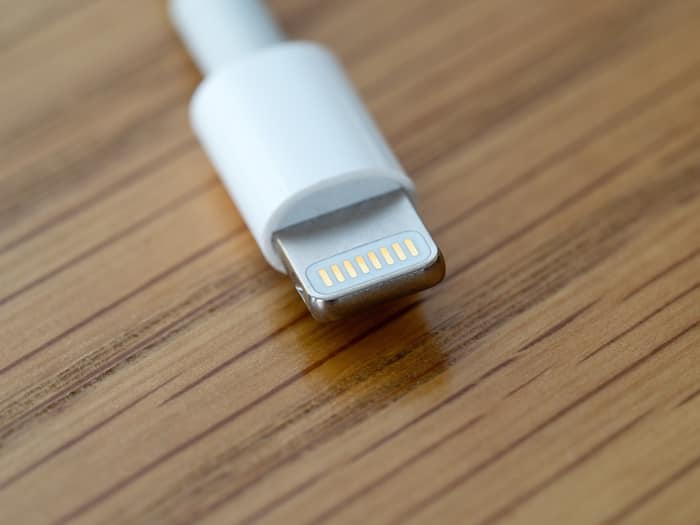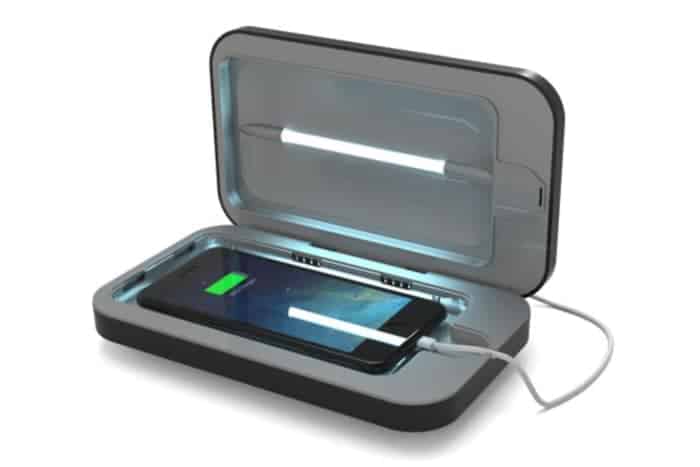
Let’s face it… you should clean your smartphone because it probably has a lot of germs.
Even if it is sitting on a table or buzzing away in your pocket it seems to want to collect dust, greasy fingerprints, and unknown stains at a moments notice.
But the good news is that there are a number of actions that you can start doing today to clean your iPhone or Android device to keep it looking and running in tip-top shape.
Depending on how dirty the smartphone is, these cleaning steps range from mild to aggressive and aim to conquer all parts of the device you’ll come across.
Before reaching for the Lysol wipe or the glass cleaner, you should carefully read through these tips so that you’re not making any mistakes.
Here are 11 tips to properly clean and sanitize your iPhone or Android smartphone the right way so that it will always stay super fresh and clean.
1. Power Off and Unplug Before Cleaning your Smartphone Device

Be sure to power off and unplug any cables that are connected before cleaning your iPhone or Android.
This will free up any exposed openings and reduce the risk of any damage caused from cleaning.
Although this is unlikely it is still wise to take this first step so that you can protect your precious investment and keep it running as best as possible.
Now you are ready to start thoroughly cleaning your smartphone.
2. Your Case May Be Attracting Most of That Grime: Clean it First
There is no doubt that a case adds that needed layer of protection for the iPhone (and Android) that shields it from scrapes, bumps, and falls that otherwise would occur without one.
But your case may also be the culprit to all that dust that you find around the edges and on the screen itself.
If you find that your case is adding all of this gunk to your smart device, simply remove the case and gently wipe around the phone with a dry, lint-free and dye-free cloth (or a t-shirt sleeve in an absolute hurry).
This should eliminate most of the dust that may have accumulated between the case and the device.
Also be sure to wipe around the inside of the case so you do not re-introduce that same lint back onto the smartphone you just wiped down.
3. Clean Your Phone with the Most Gentle Approach First

You may find it easy to start using a household cleaning solution to blast away that grime that’s on your iPhone or Android device, but this is actually the most aggressive approach and not recommended.
Instead, start with the most gentle approach first, which in most cases will be a dry lint-free cloth, similar to one that is used for cleaning eyeglasses.
Also be sure to use the lightest pressure possible when wiping around all the different areas to avoid scratching.
If you find that the grease or debris is still visible, work your way up to a slightly damp cloth with only water or soapy water and continue using light force while wiping in an up-down linear motion.
As an absolute worst case, you can use a 50:50 mix of isopropyl alcohol and water to slightly dampen the cloth and wipe around the smartphone.
But this strategy is strongly not recommended unless absolutely needed since this can wear away at the oleophobic coating that keeps fingerprints from appearing on the screen.
4. Avoid Using Paper Based Products To Clean Your Device Screens
Believe it or not, the smartphone and tablet screen is one of the most delicate parts of the device.
This is because the screen contains many touch sensors and a special oleophobic coating that has fingerprint-resistant qualities and repels oil.
It is best to keep the coating performing in its best shape so that wiping the screen with a dry cloth will eliminate most all smudges from the area.
Always Remember: it is not recommended to use an abrasive material such as paper towels, tissues, napkins, newspapers, or any other paper-based products to clean your device’s screen, as this can compromise the quality of the oleophobic coating over time.
If you find that the oleophobic coating has worn off and smudges are hard to wipe off, consider applying a glass screen protector to freshen up that coating.
5. Check And Clean The Charge Port For Lint Or Other Debris
It may be easy to overlook, but the charge port can make or break the iPhone and Android’s ability to perform well since it is powered by its battery.
Since the charge port on your smartphone is always open and exposed to the elements, it’s actually very possible for the port to accumulate so much grime that your phone or tablet won’t charge or transfer data.
Be sure to check this crucial area by shining a light into its opening and determine how dirty it is.
If you find it hard to charge your phone or that lightning cables won’t work, then it’s most likely time to clean the charge port.
Use the SIM pin key that came with your smartphone, or a safety pin or similar if you can’t find it and gently scrape around the inside of the port opening.
Shine the light back inside the opening again and check for any residual debris.
6. Wipe Clean the Lightning Or USB-C Charging Cable

With all that debris that might be in your charge port, connecting a lightning or USB-C charging cable to it can also corrode the ends since lint and grime can be transferred to it.
Look at the lightning or USB-C end of your cable (the smaller end with the gold contacts) and see if it contains any lint or debris that may have come from the charge port or wherever it has been stored.
If you find that it is dirty, gently rub the end of the cable with a damp cloth until the contacts are a shiny gold or silver.
Cleaning the contacts of the cable and the charge port will maintain the charging performance of your smartphone and tablet.
Also consider if the cable is bent or frayed. This will also affect the performance of the connection and will need to be swapped if it is not working correctly.
7. Be Mindful to Clean Inside Parts of the Device That Are Easy to Miss
The smartphone is a sleek, simple(ish) looking device. But there are complex components in and around it that are designed keep it running its absolute best.
If these complex areas in particular are not kept clean, certain features can act like they are not working like they used to, or even work as fast or efficient as before.
These spots include the Touch ID home button on iPhone 8 and previous, Face ID on iPhone X and newer, and the camera lens covers on front and back. This includes fingerprint and front-facing cameras for Android devices as well.
It is best to keep the home button (if yours has this feature) as clean as possible at all times since the security of the iPhone and Android is based on its Touch ID.
This can be done by keeping a lint-free cloth handy and wiping the button regularly. If a more aggressive approach is needed, clean using a slightly damp cloth. Harsh soaps and cleaning solutions are not recommended.
The Face ID feature on iPhone X and newer is similar in that its security is hindered by its effectiveness.
This can be found along the notch to the left of the earpiece and should also be kept as clean as possible.
It is easy for this area to get greasy since the earpiece goes against your ear, and its efficiency relies on a clean see-through surface to read your face for access.
Simply wipe the Face ID sensor with a dry lint-free cloth and in worst cases a slightly damp one. Do not use harsh chemicals or abrasive materials to clean here.
8. Do Not Blow Compressed Air Directly On Your Device
I love using compressed air for a lot of my gadgets, such as my MacBook, game consoles, and remotes.
However, direct compressed air is pretty frowned upon for cleaning inside smartphones .
This is because the excess force of the compressed air can push contaminants deeper inside the iPhone or Android phone, where more sensitive components operate.
Consider instead to use a very soft toothbrush to dislodge any debris around the headphone jack (if your smartphone or tablet has one), speakers, and microphone openings.
Finish cleaning those areas with the dry cloth and assess if there is any residue left.
9. Clean Inside Tiny Toggle Switches to Avoid Corrosion
It’s so small that you have to use a fingernail to toggle it, yes it is the mute toggle button.
The small and somewhat deep nature of this button makes it incredibly easy to attract lint and dust.
Adding a case into the mix does not make things any easier either. Leaving a case on the iPhone over a long period of time can wreak havoc on this toggle button since it make the space even deeper for grime to enter.
Following our advice by cleaning gentle first then more aggressive if needed, start by using a narrow cleaning device such as a cotton swab. This makes it easy to reach deep crevices and pick up lint that is found in there.
You will know if this button needs cleaning because it will get so hard to toggle that it will not switch at all. That means a swab session is overdue.
If the toggle switch is still not working and a tougher approach is needed, use a toothpick or something with a blunt narrow tip and gently scrape any material that’s found in there.
Continue scraping until the toggle breaks free again and you are back to ring and vibrate freedom.
10. Kill Those Bacteria With a UV Light

It is no secret that Apple strongly does not encourage you to clean your iPhone with abrasive compounds like Windex, Clorox, or Lysol.
But that doesn’t mean that your device has to live a life covered in germs.
In fact, there is some scientific evidence to suggest that UV light can kill viruses, bacteria, and pathogens.
I personally charge my iPhone every night with this Phone Soap that I purchased here on Amazon. It cradles and charges my phone wirelessly while shining a UV light continuously that safely kills germs and sterilizes my device.
Using a UV light also doesn’t compromise the oleophobic coating on the screen or back glass since there is absolutely no rubbing, water, isopropyl alcohol, or cleaning chemicals involved to try and accomplish the same task.
11. Use A Cleaning Putty to Attract Loose Debris and Dust
People usually use cleaning putty to clean dust and debris off of computer keyboards and mouse buttons.
But did you know you could also use it to keep that same loose debris off of your iPhone as well?
You can even make your own DIY cleaning putty, but I highly recommend keeping this putty on Amazon that’s less than $7 handy.
It works wonders for lifting all sorts of grime off my iPhone and I keep a cup in my office, kitchen, and bedroom so it is ready for any quick accidents.
BONUS TIP: Always Keep your smartphone Moisture-free
Most iPhone and Android smartphone models have a decent water resistance rating, where the newer models can withstand up to a half hour underwater in less than 5 meters deep.
But this is the rating for fresh water only.
The iPhone in particular is not designed to be dunked in chemical-filled or salt water.
If in the case that you accidentally spill your phone in salt water or a pool, quickly get the phone out of there and run fresh tap water over the device to wash off any residue.
Running tap water over the iPhone as a general cleaning practice is not recommended, especially if the phone has any cracks along the glass or openings around the rubber seal.
As time goes on, the rubber that seals the body of your iPhone from the elements deteriorates and can create gaps that allows moisture and water to enter, thus damaging the phone.
So clean your smartphone using the steps above, and you will have a device that will continue running fresh over a much longer time than one that’s lived a grime filled life.
Want an even deeper clean? I wrote an article covering the 5 ways to organize your home screen by making folders for your apps on iPhone.
